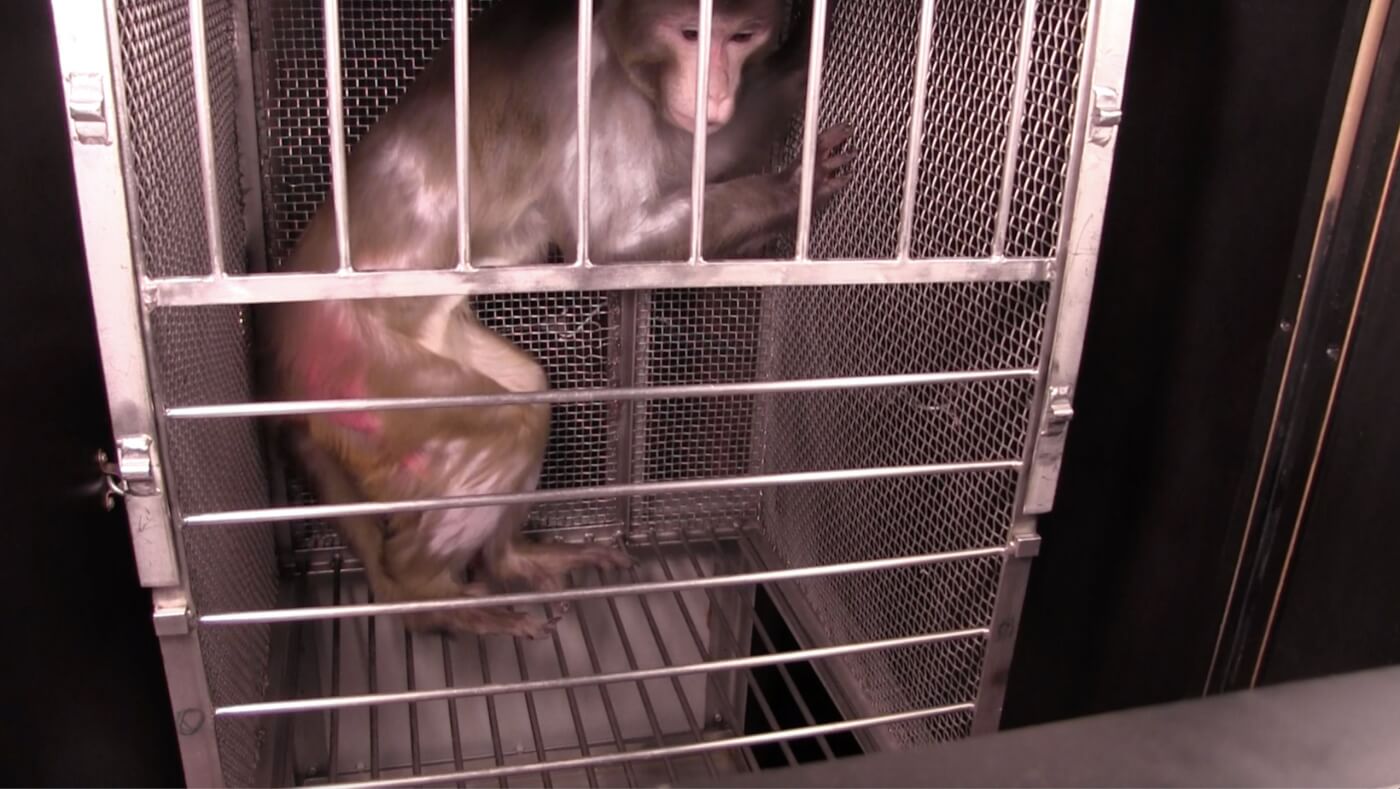Used, Abused, and Traumatized: Meet Guinness, a Monkey Prisoner at NIH
For Guinness, a 18-year-old rhesus macaque bred to be used and abused in laboratory experiments, loneliness is the order of the day—and the next day and the one after that.
Caged alone for the past 14 years in the National Institutes of Health (NIH) laboratory of experimenter Elisabeth Murray in Bethesda, Maryland, Guinness has never known life as part of a troop with other rhesus macaques living in their natural habitat. Instead, he’s been isolated, cut open, restrained, injected, and subjected to confusing procedures. A titanium post has been embedded in his skull and a tight metal collar fitted around his neck. For years, the unrelenting stress and frustration of endless confinement have caused him to rip out his own hair.
This is his story.
Guinness Was Born Into Misery
On May 25, 2005, a baby macaque was born at Alpha Genesis, a notorious South Carolina facility that breeds and sells sentient beings for profit as though they were car parts. It was the first day of a life that would be marked by isolation, deprivation, and suffering.
Treated with little more care than a muffler or a set of brake pads, primates at Alpha Genesis have frozen to death and died of dehydration. One juvenile monkey was killed when she was caged with and attacked by other stressed, imprisoned monkeys. Another monkey died after being shot with a dart gun that ruptured her internal organs.
The baby macaque—later named Guinness—would face a different horror. At age 2, he would be shipped off to NIH.
Crumbling Mentally and Physically
At NIH, Guinness was assigned to the laboratory of serial monkey torturer Murray. Like humans, rhesus macaques are profoundly social beings, and at first, Guinness was spared the torment of solitary confinement: He was caged with another prisoner of Murray’s laboratory named Smithwick. But the pair were separated in 2009.
Since then, Guinness has lived in isolation—locked inside a cage so small that he can only take a few steps in any direction, unable to touch or be touched by another monkey.
As his psychological state deteriorated, so, too, did his physical appearance. Records indicate that in 2008, he started to tear out his own hair—leaving bald patches on up to 73% of his body. Experimenters in later years observed that he was rocking back and forth and circling agitatedly in his cage.
Experimenters responded to Guinness’ clear signs of anguish by periodically giving him what they called “enrichment”—but it was just a few banana chips, a handful of trail mix, or a smattering of cereal. He continued to rip out his own hair.
Guinness Was Cut Open, Trapped, and Terrified
In 2010, experimenters in Murray’s laboratory sedated Guinness and fitted a metal collar around his neck. Like so much of what they did to him, this procedure was about convenience and control: Experimenters could hook him by the collar using a metal pole to move him where they pleased.
On another occasion, experimenters drilled into his skull to implant a titanium head post—making it easier to force him to hold his head still during experimental trials. Later, an open, infected wound developed around the screws.
Like Beamish and dozens of other monkeys in Murray’s laboratory, Guinness was locked inside a small metal box with a guillotine door that lifted to reveal some of his worst fears: snakes and spiders. Although they were artificial, some of them moved and jumped. Video of Guinness taken during these experiments shows him turning away and scratching at the sides of the cage in a frantic effort to escape.
This Torment Must End Now
Fourteen years after arriving at NIH, Guinness is still there—subject to experimenters’ every whim for as long as they choose to keep him alive. Not a moment of his life has been under his own control—not what he eats, where he sleeps, or with whom he interacts.
Meanwhile, Murray has built a career out of the suffering of Guinness and hundreds of other monkeys—reducing their terror and torment to graphs and words in a journal article. As she pats herself on the back for another publication, Guinness and the other prisoners in her laboratory continue to endure misery, without a single cure or treatment for humans to show for their anguish.
Not one more monkey should be condemned to a life like this. Click the button below to help end the torment of sentient beings like Guinness today.

